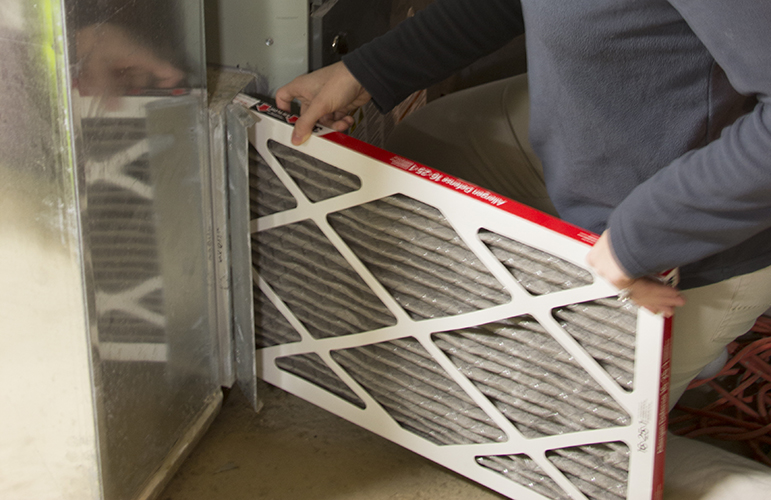As the seasons change, so do the demands on your HVAC system. Whether you’re turning on the heat during the frosty winter months or seeking refuge from the summer swelter with air conditioning, one thing remains constant: the importance of a clean HVAC filter. As an experienced HVAC technician with PGX Heating and Cooling, I’ve witnessed firsthand the impact that a neglected filter can have on system performance and indoor air quality. In this guide, I’ll share my professional insights on when and how to change your HVAC/furnace filter for optimal performance and maintenance year-round.
Importance of Regular HVAC Filter Changes
Your HVAC system’s filter plays a crucial role in maintaining indoor air quality and preserving the efficiency of your equipment. Over time, the filter accumulates dust, pollen, pet dander, and other airborne particles, restricting airflow and hindering system performance. A clogged filter forces your HVAC system to work harder, leading to increased energy consumption, higher utility bills, and potential damage to system components.
Moreover, dirty filters can compromise indoor air quality, exacerbating respiratory issues and allergies. By regularly replacing your filter, you not only improve system efficiency but also ensure a healthier indoor environment for you and your family.
When to Change Your HVAC/Furnace Filter?
Determining the ideal frequency for filter changes depends on various factors, including the type of filter, household occupancy, pets, and environmental conditions. However, as a general rule of thumb, I recommend checking your filter every 30 days and replacing it as needed. Here are some indicators that it’s time for a filter change:
Visual Inspection: Take a moment to visually inspect your filter. If it appears gray and clogged with debris, it’s time for a replacement.
Reduced Airflow: Notice a decrease in airflow from your vents? A dirty filter could be to blame, restricting the passage of air through your HVAC system.
Increased Energy Bills: Keep an eye on your energy bills. A sudden spike in utility costs could indicate that your HVAC system is working harder than usual, often due to a clogged filter.
Visible Dust: If you notice an accumulation of dust around your vents or on furniture despite regular cleaning, it may be a sign that your filter is no longer effectively capturing airborne particles.
Seasonal Changes: With the onset of each new season, it’s wise to check and potentially replace your filter. Increased system usage during extreme temperatures can accelerate the accumulation of debris.
Choosing the Right Filter
When selecting a replacement filter for your HVAC system, you’ll encounter various options, including fiberglass, pleated, HEPA, and electrostatic filters. Each type offers different levels of filtration and efficiency, so it’s essential to choose one that aligns with your specific needs and budget.
Fiberglass Filters: These inexpensive filters offer basic filtration and are suitable for households with minimal allergen concerns. However, they typically need to be replaced more frequently.
Pleated Filters: With a higher surface area, pleated filters capture more particles and provide better filtration than fiberglass filters. They are an excellent choice for improving indoor air quality.
HEPA Filters: High-Efficiency Particulate Air (HEPA) filters excel at trapping microscopic particles, making them ideal for allergy sufferers and households with pets. While more expensive, HEPA filters provide superior air purification.
Electrostatic Filters: These reusable filters use an electrostatic charge to attract and capture particles. While initially more costly, electrostatic filters offer long-term savings and environmental benefits.
Consider factors such as MERV (Minimum Efficiency Reporting Value) ratings when comparing filters. A higher MERV rating indicates better filtration, but it’s essential to ensure compatibility with your HVAC system to avoid airflow restrictions.
How to Replace Your HVAC Filter
Changing your HVAC / furnace filter is a relatively simple task that can be completed in a few easy steps:
Turn Off the System: Before replacing the filter, switch off your HVAC system to prevent damage and ensure your safety.
Locate the Filter: Depending on your system’s configuration, the filter may be located behind a grate or within the air handler unit. Refer to your owner’s manual for guidance.
Remove the Old Filter: Carefully slide out the old filter from its housing. Take note of the direction of airflow indicated on the filter frame to ensure proper installation of the new filter.
Install the New Filter: Insert the new filter into the housing, ensuring it fits securely and aligns with the airflow direction arrow.
Secure the Housing: If applicable, replace the cover or grille and ensure it is securely fastened to prevent air leaks.
Turn On the System: Once the new filter is in place, switch on your HVAC system and enjoy improved performance and air quality.
Conclusion
Regularly changing your HVAC/furnace filter is a simple yet essential maintenance task that can have a significant impact on your system’s efficiency and indoor air quality. By following the guidelines outlined in this article, you can ensure that your HVAC system operates smoothly year-round, keeping you comfortable and healthy. Remember, when it comes to filter replacement, proactive maintenance is key. Don’t wait until your system shows signs of distress—stay ahead of the curve and reap the benefits of a clean, well-maintained HVAC system. If you’re local to the Pittsburgh, PA area and ever need assistance with your HVAC maintenance or repairs, don’t hesitate to reach out to our team at PGX Heating and Cooling. We’re here to help you keep your home comfortable and your HVAC system running at its best.

